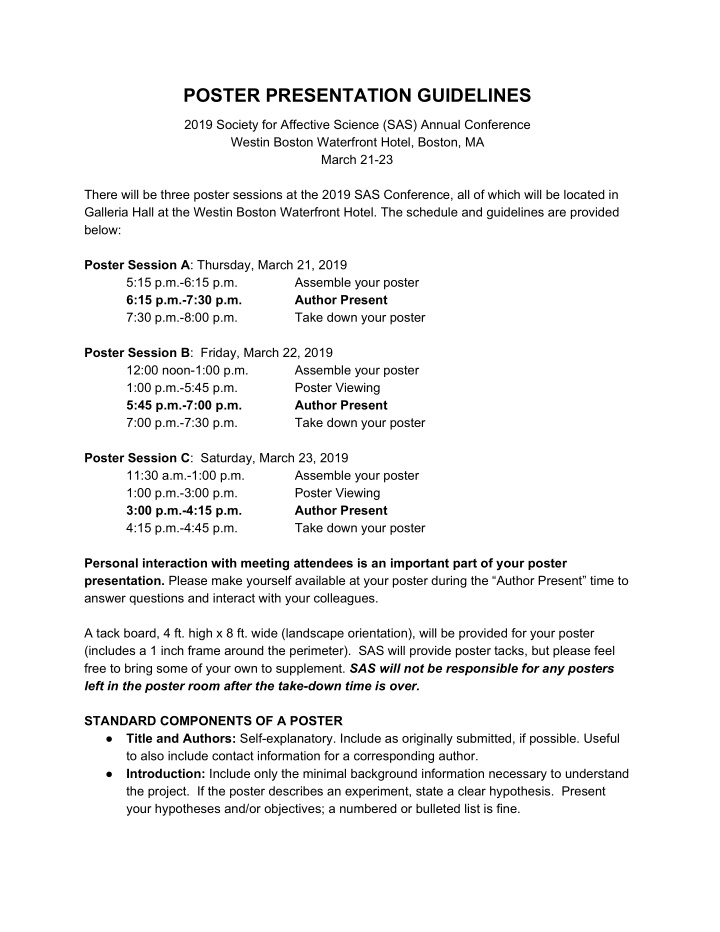



POSTER PRESENTATION GUIDELINES 2019 Society for Affective Science (SAS) Annual Conference Westin Boston Waterfront Hotel, Boston, MA March 21-23 There will be three poster sessions at the 2019 SAS Conference, all of which will be located in Galleria Hall at the Westin Boston Waterfront Hotel. The schedule and guidelines are provided below: Poster Session A : Thursday, March 21, 2019 5:15 p.m.-6:15 p.m. Assemble your poster 6:15 p.m.-7:30 p.m. Author Present 7:30 p.m.-8:00 p.m. Take down your poster Poster Session B : Friday, March 22, 2019 12:00 noon-1:00 p.m. Assemble your poster 1:00 p.m.-5:45 p.m. Poster Viewing 5:45 p.m.-7:00 p.m. Author Present 7:00 p.m.-7:30 p.m. Take down your poster Poster Session C : Saturday, March 23, 2019 11:30 a.m.-1:00 p.m. Assemble your poster 1:00 p.m.-3:00 p.m. Poster Viewing 3:00 p.m.-4:15 p.m. Author Present 4:15 p.m.-4:45 p.m. Take down your poster Personal interaction with meeting attendees is an important part of your poster presentation. Please make yourself available at your poster during the “Author Present” time to answer questions and interact with your colleagues. A tack board, 4 ft. high x 8 ft. wide (landscape orientation), will be provided for your poster (includes a 1 inch frame around the perimeter). SAS will provide poster tacks, but please feel free to bring some of your own to supplement. SAS will not be responsible for any posters left in the poster room after the take-down time is over. STANDARD COMPONENTS OF A POSTER ● Title and Authors: Self-explanatory. Include as originally submitted, if possible. Useful to also include contact information for a corresponding author. ● Introduction: Include only the minimal background information necessary to understand the project. If the poster describes an experiment, state a clear hypothesis. Present your hypotheses and/or objectives; a numbered or bulleted list is fine.
● Method: Describe your participants, materials, and procedures in simple, concise terms. This section should be much less detailed than in a manuscript. Use figures, tables, charts instead of text, if possible. Use limited references for complex procedures. ● Results: Display your findings graphically as figures or tables. As above, use figures, tables, charts instead of text where possible. In many cases, figures and well-written figure captions alone can represent your results. ● Discussion: Revisit your hypothesis and state whether it was supported by the results. Briefly consider limitations and suggestions for future research. Explain how this work makes a novel contribution to the field. ● References: Provide a limited list of references. SUGGESTIONS TO MAXIMIZE THE IMPACT OF YOUR POSTER ● Arrange your poster so that the information flows and the sequence can be easily followed within the space allowed (4 ft. high x 8 ft. wide, including a 1 inch frame around the perimeter). ● Be brief and simple. Condense or limit large amounts of data. Limit the number of hypotheses/objectives that you tackle. Limit the number of tables and figures to only the most critical to bring out key points. ● Use figures instead of text where possible and use LARGE PRINT for text. The audience should know what you did, why, and what you found by viewing your poster from at least five feet away and within two minutes of time . Lists help to save space, tie everything together, and are easier to read/digest. ● Standardize all nomenclature and define all abbreviations . Avoid excessive use of abbreviations. ● Label everything (e.g., figure axes). Proofread carefully. Tables should only contain the most important information. ● Excellent and entertaining advice on preparing posters can be found here . There are several options for poster printing, including: ● Spoonflower - Spoonflower has offered 2019 SAS attendees a 15% discount on fabric posters! The order deadline for standard shipping is March 4. [ link ]. ● Make Signs Scientific Posters [ link ] ● FedEx Store [ link ] A friendly reminder that all presenters must register for the conference. Please do so if you have not already. Questions? Please contact Jane Shepard .
Recommend
More recommend